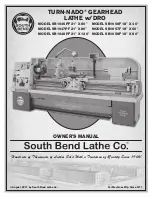
For Machines Mfg. Since 3/11
EVS Toolroom Lathe w/DRO
-35-
P R E P A R A T I O N
Spindle Break-In
Before subjecting the lathe to full loads, it
is essential to complete the spindle break-in
process as described below. This will ensure the
best results and maximum life of the precision
components inside the lathe.
The break-in procedure must be performed
in succession with the
Test Run
procedure
described in this manual, because many of the
test run steps prepare the lathe controls for the
break-in process.
Important:
Do not perform the break-in
procedure independently from the
Test Run
section—serious damage could occur to the lathe
if the controls are set differently than instructed
in that section.
Do not leave the lathe unattended during the
Spindle Break-In procedure. If your attention
is needed elsewhere during this procedure,
stop the lathe and restart the procedure later
from the beginning.
5.
While the oil is still warm and any metal
particles are still suspended in the oil,
change the headstock and gearbox oil (refer
to
Lubrication
beginning on
Page 68
for
detailed instructions).
6.
Check the V-belt tension, and if necessary,
re-tension them (refer to
V-Belts
on
Page
81
for detailed instructions).
Congratulations! The spindle break-in is
complete.
To perform the spindle break-in:
1.
Successfully complete the
Test Run
procedure beginning on
Page 32
.
2.
Using the speed dial on the control panel
and the spindle speed range lever to set the
spindle speed, run the lathe for ten minutes
at each of the following speeds: 55, 180, 600,
and 1800 RPM.
3.
Use the foot brake to stop spindle rotation,
then reverse spindle rotation and run the
lathe at 1800 RPM for 10 minutes.
4.
Use the foot brake to stop spindle rotation,
then run the lathe at 180 RPM for ten
minutes with the gearbox range lever on the
headstock in the
L
(low) position, and then
run the lathe another ten minutes with the
lever in the high position.
For your convenience, the adjustments listed
below have been performed at the factory.
However, because of the many variables involved
with shipping, we recommend that you at least
verify the following adjustments to ensure the
best possible results from your new machine.
Step-by-step instructions for these adjustments
can be found on the pages referenced below.
Factory adjustments that should be verified:
s
4AILSTOCKALIGNMENT
Page 45
).
s
#OMPOUNDANDCROSSSLIDEBACKLASH
adjustment (
Page 78
).
s
'IBADJUSTMENTS
Page 79
).
Recommended
Adjustments
















































